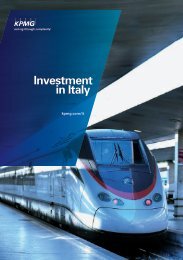Innovation Canada: A Call to Action
Innovation Canada: A Call to Action
Innovation Canada: A Call to Action
Create successful ePaper yourself
Turn your PDF publications into a flip-book with our unique Google optimized e-Paper software.
<strong>Innovation</strong> <strong>Canada</strong>: A <strong>Call</strong> <strong>to</strong> <strong>Action</strong>forthcoming defence purchases, especially bySMEs. (The commercialization model developedby Sustainable Technology Development <strong>Canada</strong>might be emulated.) There is urgency in thissince, if Canadian capabilities were <strong>to</strong> remainunderdeveloped at the time of contracting, IRBoffsets would be directed more <strong>to</strong>wardtraditional “build <strong>to</strong> print” work, rather thanleading-edge technology development andcommercialization. In order <strong>to</strong> achieve criticalmass quickly, the government could considersome form of matching formula with the primecontrac<strong>to</strong>rs. It is emphasized that taking fulladvantage of Crown procurements depends ongovernment and business investments early on,in order <strong>to</strong> get the desired innovation capacitybuildingleverage from an IRB, whose costs areborne by prime contrac<strong>to</strong>rs. This might involvesharper focus of existing programs, rather thanadditional resources.3.5 Working collaboratively — Exploreavenues of collaboration with provincialand municipal governments regarding theuse of procurement <strong>to</strong> support innovationby Canadian suppliers and <strong>to</strong> fostergovernments’ adoption of innovativeproducts that will help reduce the cost andimprove the quality of public services.Annual procurement by provinces andmunicipalities across <strong>Canada</strong> substantiallyexceeds federal procurement because of theirresponsibilities for health care, education andtransportation infrastructure, among otherpublic services. All orders of government shouldcollaborate <strong>to</strong> develop and share best practicesin the use of procurement <strong>to</strong> foster innovativeCanadian companies and, where feasible, <strong>to</strong>develop joint strategies <strong>to</strong> enhance the leverageof public procurement in certain sec<strong>to</strong>rs.The Large-Scale ResearchCollaboration GapThe basic research performed by universities andother labora<strong>to</strong>ries generates disruptivetechnologies that open up whole newindustries. At colleges, polytechnics anduniversities, there is also a broad range ofapplied research relevant <strong>to</strong> both the businessand non-profit sec<strong>to</strong>rs. This applied research caninclude business-oriented areas such as finance,regulation/legislation and organizationalbehaviour, and also covers the domains ofapplied science and technology — for example,forestry and geosciences, engineering,computer science and information systems,nanotechnology, chemistry, life sciences, andhealth research. Much of this research, evenwhen investiga<strong>to</strong>r initiated and funded bygovernment or non-profit agencies, is relevant<strong>to</strong> industry and is taken up in various ways.Reflecting the benefit of this system <strong>to</strong> industry,business-sponsored research in <strong>Canada</strong>’suniversities currently <strong>to</strong>tals more than$785 million a year (Canadian Association ofUniversity Business Officers 2010). Across thecountry, there is an array of ad hoc small-scale,needs-based collaborations under way betweenthe business and post-secondary sec<strong>to</strong>rs,assisted by the network and collaborationprograms discussed in Chapter 5.In recognition of the vital role that postsecondaryeducation institutions play in oursystem of innovation — foremost, as theprimary source of highly qualified and skilledpersonnel and, secondly, as a source of leadingedgeideas and knowledge — the Governmen<strong>to</strong>f <strong>Canada</strong> has substantially increased itssupport for higher education R&D over the past15 years. Given the foundational role that astrong post-secondary education sec<strong>to</strong>r plays inthe Canadian system of innovation, this Panel(like the Expert Panel on Commercializationbefore it) urges the government <strong>to</strong> commit <strong>to</strong>investing in basic research at internationally7-6
















